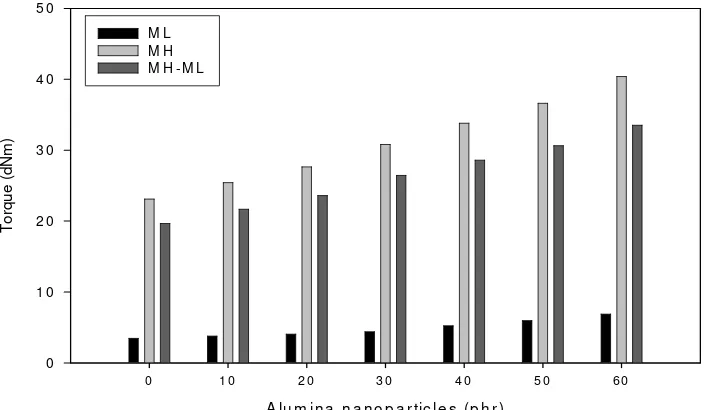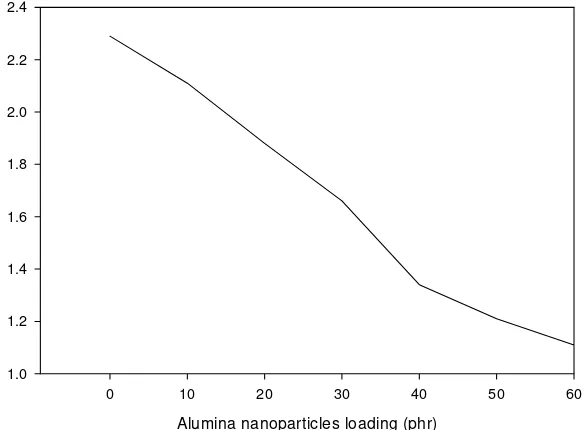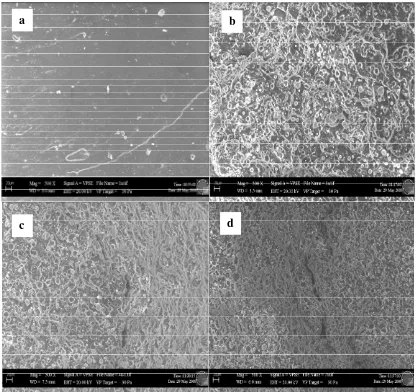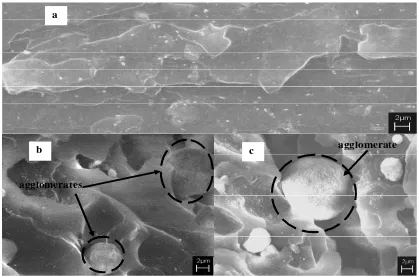ISSN 1450-216X Vol.24 No.4 (2008), pp.538-547 © EuroJournals Publishing, Inc. 2008
http://www.eurojournals.com/ejsr.htm
The Effect of Filler on Epoxidised Natural Rubber-Alumina
Nanoparticles Composites
Noraiham Mohamad
Department of Mechanical & Materials Engineering, Faculty of Engineering Universiti Kebangsaaan Malaysia, 43600 Bangi, Selangor, Malaysia
E-mail: noraiham@vlsi.eng.ukm.my Tel: +60-38921 6258; Fax: +60-38925 9659
Andanastuti Muchtar
Department of Mechanical & Materials Engineering, Faculty of Engineering Universiti Kebangsaaan Malaysia, 43600 Bangi, Selangor, Malaysia
Mariyam Jameelah Ghazali
Department of Mechanical & Materials Engineering, Faculty of Engineering Universiti Kebangsaaan Malaysia, 43600 Bangi, Selangor, Malaysia
Dahlan Hj. Mohd
Malaysian Nuclear Agency 43000 Bangi, Selangor, Malaysia
Che Husna Azhari
Department of Mechanical & Materials Engineering, Faculty of Engineering Universiti Kebangsaaan Malaysia, 43600 Bangi, Selangor, Malaysia
Abstract
Keywords: Epoxidised Natural Rubber, Alumina Nanoparticles, Cure, Mechanical, Fracture
1. Introduction
Much research has been carried out in the development of nano-filled composites through the incorporation of nano-scaled materials such as ceramics and carbon in polymer matrices. For instance organoclays [1], carbon nanotubes [2], alumina nanoparticles [3] and silica nanoparticles [4] have been added to polymers. Polymer nanocomposites exhibit unique properties even by the addition of low weight percent nanofillers (<5 wt%), that cannot be obtained from conventional or micro- scale fillers [5]. The incorporation of nanofillers enhances mechanical, electrical, optical and other properties of polymer composites without sacrificing too much of the good properties such as the toughness being traded for the stiffness as such found in the rubber filled carbon fibres [6]. Several polymers have been used for preparing polymer nanocomposites such as elastomers (natural rubber (NR), epoxidised natural rubber (ENR), styrene-butadiene rubber (SBR), chloroprene rubber (CR), ethylene propylene diene monomer rubber (EPDM) etc.), thermoplastics (nylon 6, 6, polypropylene (PP), polyethylene terephthalate (PET), polymetylmetacrylate (PMMA), polycarbonate etc.), and polymer blends.
The development of polymer-ceramic nanocomposites has created a number of technologies and opportunities that can be applied to ENR. In a previous research by Teh et al.[1], ENR was used as a compatibiliser in producing natural rubber-organoclays nanocomposites. Organoclays can be more easily dispersed in polar polymers compared to non-polar polymers such as NR [1]. ENR is miscible with more polar polymers [7] thereby offering unique properties such as good oil resistance, low gas permeability, higher wet grip, rolling resistance, and a high strength. The oil resistance of ENR 50 vulcanisate was reported to approach the characteristics of medium-acrylonitrile-content nitrile rubber and also surpasses that of CR [7]. The resistance to air permeability of ENR 50 has also been claimed to be comparable to butyl rubber and medium-acrylonitrile-content nitrile rubber [7]. Alumina has been recognised as a structural material with an extremely high melting point (2050 C), high hardness, and capable to take on diverse shapes and functions [8]. The incorporation of nano-scaled alumina in PP has improved the mechanical properties of the polymer composites [9] and increased the wear resistance of PET filled alumina nanoparticles by nearly 2× over the unfilled polymer [10].
The ENR-alumina nanoparticles composites can be prepared using procedures as those used for NR. Rubber nanocomposites with an exfoliated morphology have been successfully prepared by several methods such as in situ polymerisation, solution blending, and direct melt compounding [11]. The solution method is widely used to prepare nanocomposites, which can be applied to ENR but this method is very inconvenient due to the use of organic solvents [12]. Hence, the melt compounding method using the internal mixer has been used to synthesise ENR-alumina nanoparticles composites.
2. Experimental
2.1. Materials
Dahlan Hj. Mohd and Che Husna Azhari
Table 1: Rubber compounding recipe.
Ingredients Loadings (phr)a
a Parts per hundred rubber
b N-cyclohexylbenthiazyl sulphenamide c Tetramethylthiuram disulfide
d N-(1,3-Dimethylbutyl)-N'-phenyl-p-phenylenediamine
2.2. Mixing & Cure Characteristic
The compounding process was performed according to ASTM D-3192 and carried out using a Haake internal mixer working at 90ºC and a rotor speed of 60 rpm for 6 min. Firstly, ENR was masticated for 1 min before all ingredients were added except sulphur and mixed for another 4 min. Finally, sulphur was added and mixed for about 1 min before the mixture was dumped onto two roll mill.
From this stock, unvulcanised samples were cut to allow testing of curing characteristics in accordance to the Test Method ASTM D-2084 using Monsanto ODR 2000 Moving Die Rheometer (Alpha Technologies, Swindon, UK) at 150ºC. Sheets with approximately 1mm and 3mm thickness were vulcanised using a semi efficient vulcanisation (EV) system in a hot press at 150ºC at the respective cure times, t90 which derived from rheometer tests.
2.3. Mechanical Properties
Tensile properties of vulcanised samples were carried out according to BS 6746 using an Instron 4301 Universal Testing Machine at room temperature. It was performed at a cross-head speed of 500mm/min.
The test for hardness was carried out using the Shore type A Zwick/Roell Durometer according to ASTM D2240.
Samples prepared according to ASTM D 256 were tested for impact strength for unnotched Izod pendulum impact resistance using a CEAST impact tester. They were dipped into liquid nitrogen for 1 min before the samples were clamped to the machine and stroked by a pendulum at an energy level of 4 J. All tests were conducted at room temperature (25°C).
2.4. Swell Measurements
Cured test pieces of dimension 30 x 20 x 1 mm were swollen in toluene (solvent) for 24 hours at room temperature. Q (the weight of toluene absorbed per gram of rubber hydrocarbon) was determined according to the following expression [7]:
(1) where Ws is the swollen weight, Wds is the deswollen weight, Wd is the dry weight and Wt is the formula weight.
2.5. Scanning Electron Microscopy (SEM)
micrographs a minimum of three frames at each magnifications were taken to ensure a high confidence level in the analysis. The objectives were to get ideas on the fracture mode and to investigate the filler dispersion and particles shape, qualitatively. The fractographs were captured under variable pressure using secondary electron operated at 20 kV.
3. Results and Discussion
3.1. Curing Characteristics
Figure 1, Figure 2 and Figure 3 depict the cure characteristics of ENRANs. It can be deduced from Figure 1 that the incorporation of alumina nanoparticles has increased the MH and ML as well as MH-ML in composites. The increment of torque values has suggested that there are good interactions between ENR and filler surfaces [11]. This can be most attributed by high compatibility between alumina nanoparticles and ENR matrix which results in some reinforcements in the composites [13].
Figure 1: Torque maximum (MH), torque minimum (ML) and torque difference (MH-ML) for different alumina nanoparticles loading (phr) in ENR matrix.
A lu m in a n a n o p a rtic le s (p h r )
0 1 0 2 0 3 0 4 0 5 0 6 0
T
o
rque
(dN
m
)
0 1 0 2 0 3 0 4 0 5 0
M L M H M H -M L
The MH can be regarded as a measure of the composites modulus [1]. The significantly increased values in MH (refer to Figure 1) with filler loading are indirect hint for improved interaction behaviour and good interfacial adhesion between matrix and filler. This claim is in line with Ciprari [14] which mentioned that for strongly binding polymers to filler surfaces there will be an area of high density and thus, high modulus forms next to the surface. Thus if all areas of the filler surfaces are capable of adsorption (high interaction), the segments of polymer chains will absorbed on the surfaces and form a flat (dense) layer close to the filler surfaces. This area will have combination properties of fillers (high modulus) and matrix [14].
Dahlan Hj. Mohd and Che Husna Azhari
Figure 2: The weight of absorbed toluene per gram of rubber, Q for different phr of alumina loading.
Alumina nanoparticles loading (phr)
0 10 20 30 40 50 60
1.0 1.2 1.4 1.6 1.8 2.0 2.2 2.4
Figure 3: The scorch time and cure time for different alumina nanoparticles loading of ENR/alumina nanoparticles composites.
Alumina nanoparticles (phr)
0 10 20 30 40 50 60
Ti
m
e
(
m
in
)
0 1 2 3 4
Cure tim e Scorch time
The addition of fillers of a smaller size tends to impose extra resistance to flow due to higher restriction to molecular motion of the macromolecules; hence higher viscosity [16].
The presence of alumina nanoparticles has accelerate curing process with a significant decrease in scorch, t2 and cure time, t90 (refer Figure 3). This may due to the effect of filler’s surface area
whereby, the smaller the particle sizes, the larger the surface area available for reaction; hence, greater interaction between matrix and the filler particles. This claim is in agreement with Ishak & Bakar [16] which reported that fillers play an important role in accelerating vulcanisation process.
3.2. Mechanical Properties
Table 2 summarises the tensile properties, hardness and impact strength of ENR filled and unfilled alumina nanoparticles.Tensile strength and EB decreases as the alumina loading increases. This result shows different trend if compared to previous research by Arroyo et al. [11]; since this present work involves with high filler loading. In a research of low filler loading conducted by Ash et al. [18]; incorporation of 5% wt alumina nanoparticles into a polymethylmethacrylate (PMMA) matrix has increased the average value of strain-to-failure up to 600%. Normally (in the case of conventional composites) tensile strength will increase with increasing filler loading until maximum point is reached; whereby the filler particles are no longer adequately separated or wetted by rubber phase [16].
In present work, reduction in tensile strength may occur due to the agglomeration of filler particles or simply the result of physical contact between adjacent agglomerates [16]. The agglomerate is a domain that can act like a foreign body in composites. Since there was a high amount of agglomerates in higher filler loading composites, these agglomerates (refer to Figure 5) act as obstacles to chains movement and initiate failure under stress. This explain why EB (refer to Table 2) showed the same trend with tensile strength; which decreases with increasing amount of filler loading. Agglomerates will become stress concentrator and building up stresses in composites quicker than usual and caused earlier rupture if compared to unfilled samples. However, a different explanation was given by Ismail & Chia [7] who claimed that poor tensile strength may be attributed to the geometry of fillers. Strength of the composites with irregularly shaped fillers decreased due to the inability of the fillers to support stresses transferred from the polymer matrices [17]. Since, the alumina nanoparticles had form sphere-like agglomerates (refer to Figure 4) in ENR matrices, this claim cannot be apply as a cause of decreasing tensile strength in present study.
However, a loading of less than 10 phr of alumina nanoparticles in ENR matrices might generate the same result as achieved by other researchers [11, 15]; which tensile strength increases with increasing filler loading.
Dahlan Hj. Mohd and Che Husna Azhari
Table 2: Mechanical properties of ENR filled various loading of alumina nanoparticles.
Alumina Nanoparticles (phr) Properties
0 10 20 30 40 50 60 Tensile strength (MPa) 20.93 17.35 17.16 16.45 16.36 15.71 14.80
Tensile modulus (MPa)
100% Elongation 0.63 0.74 0.75 0.97 0.99 1.15 1.34
300% Elongation 2.68 2.94 3.70 4.16 4.26 4.96 5.44
Elongation at break, EB (%) 625 557 540 540 525 521 495 Hardness (Shore A) 11.7 12.5 13.63 14.43 15.73 17.13 18.93 Impact Strength (J/m) 239.75 215.55 175.24 172.39 168.74 168.48 153.95
The tensile properties are in agreement with the results obtained from the analysis of the hardness and impact strength. The increase in hardness is related with high tensile modulus and the increasing amount of hard alumina nanoparticles in the ENR matrices. On the other hand, as can be suggested from the impact test, the elastic behavior of the matrix proportionately varies with the addition of the alumina nanoparticles. As the loading of alumina fillers increases, the ability of the composites to absorb impact energy decreases since there are less ratio of the rubber matrix to fillers. This result in decreasing impact strength which explained the capability of the composites to withstand energy berfore fracture.
3.3. Morphology of Fracture Surfaces and Filler Dispersion
Figure 4 and Figure 5 display SEM micrographs taken from the tensile fracture surfaces for unfilled and filled ENR at magnification of 500x and 5000x, respectively. The dark phase represents the ENR matrix and the bright phase corresponds to the alumina particles. Fractographs in Figure 4 show alumina nanoparticles have uniformly distributed in the composites but poorly dispersed. There are fillers that form clusters (agglomerates) or aggregates (further examination under transmission electron microscope (TEM) in future study) with size larger or smaller than original size of starting alumina nanoparticles (30-80nm) presence in the composites.
Figure 4: SEM fractographs using secondary electron at 500x magnification for (a) 0 phr (b) 20phr (c) 30 phr (d) 60 phr of alumina nanoparticles loading in ENR.
a
d c
b
From the fractographs in Figure 4, surface roughness decreases with further increasing filler loading from 30 phr to 60 phr. It can be observed that the density of agglomerates increases as the alumina content was further loaded (refer to Figure 4). This may due to the worsening wettability of matrix onto filler surface when ratio of fillers to ENR matrix is too high, hence premature or brittle type fracture [1]. It can be observed in Figure 5(c) where unwetted alumina agglomerate was solely present in between crack surfaces of high filler loading composite (60 phr). Composites with low filler loading show higher tensile strength if compared to composites with higher filler loading since there were less agglomerates and better wettability in the composites.
Dahlan Hj. Mohd and Che Husna Azhari
Figure 5: Fractographs under 5000x magnification. (a) unfilled ENR; ductile fracture. (b) 10 phr alumina loading; show similar contrast. (c) 60 phr alumina loading; show alumina agglomerates which act as foreign body and initiate crack during tensile deformation.
agglomerate
agglomerates b
a
c
4. Conclusions
The incorporation of alumina nanoparticles in ENR accelerated curing process and improved curing characteristics. Adding high amounts of alumina nanoparticles did not cause pronounced effect to the tensile properties. The tensile strength and elongation at break decreased with increasing alumina content in composites but increased the tensile modulus.The presence of alumina nanoparticles in ENR matrix has reduced the impact strength and improved hardness of ENRANs up to 60% than unfilled ENRs. Morphology of fracture surfaces shows that tensile properties are not only affected by crosslink density but also better distribution, agglomeration and wettability. The presence of uniformly distributed alumina nanoparticles have effeciently hinder the polymer chains movement during deformation and contribute to the high stiffness of the composites.
5. Acknowledgement
References
[1] P.L. Teh, Z.A. Mohd Ishak, A.S. Hashim, J. Karger-Kocsis and U.S. Ishiaku, “Effects of epoxidized natural rubber as a compatibilizer in melt compounded natural rubber–organoclay nanocomposites,” Euro. Poly. J., 40, 2004, pp. 2513–2521.
[2] A.M. Shanmugharaj, J.H. Bae, K.Y. Lee, W.H. Noh, S.H. Lee and S.H. Ryu, “Physical and chemical characteristics of multiwalled carbon nanotubes functionalized with aminosilane and its influence on the properties of natural rubber composites,” Compo. Sci. & Tech., 67, 2007, pp. 1813–1822.
[3] R.W. Siegel, S.K. Chang, B.J. Ash, J. Stone, P.M. Ajayan, R.W. Doremus, and L.S. Schadler, “Mechanical behavior of polymer and ceramic matrix nanocomposites,” Scripta mater., 44, 2001, pp. 2061–2064.
[4] S.J. Park, S.Y. Jin, and S. Kaang, “Influence of thermal treatment of nano-scaled silica on interfacial adhesion properties of the silica/rubber compounding,” Mater. Sci. & Eng. A., 398, 2005, pp. 137–141.
[5] M.A. López-Manchado, J.L. Valentín, J. Carretero, F. Barroso and M. Arroyo, “Rubber network in elastomer nanocomposites,” Euro. Poly. J., 2007.
[6] P.M. Ajayan, L.S. Schadler and P.V. Braun, “Nanocomposite Science and Technology,” WILEY-VCH Verlag GmbH & Co. KGaA, Weinheim, 2003.
[7] H. Ismail and H.H. Chia, “The effects of multifunctional additive and vulcanization systems on silica filled Epoxidized Natural Rubber compounds,” Euro. Poly. J., 34, 12, 1998, pp.1857-1863.
[8] I. Noboru, “Introduction to Fine Ceramics (Application in Engineering),” John Wiley & Sons Ltd, 1987.
[9] C.H. Jung, J.H. Choi, Y.M. Lim, J.P. Jeun, P.H. Kang and Y.C. Nho, “Preparation and Characterization of Polypropylene Nanocomposites Containing Polystyrene-grafted Alumina Nanoparticles,” J. Ind. Eng. Chem., 12, 6, 2006, pp. 900-904.
[10] P. Bhimaraj, D.L. Burris, J. Action, W.G. Sawyer, C.G. Toney, R.W. Siegel and L.S. Schadler, “Effect of matrix morphology on the wear and friction behavior of alumina nanoparticle/ poly(ethylene) terephthalate composites,” Wear, 258, 2005, pp. 1437–1443.
[11] M. Arroyo, M.A. Lo´pez-Manchado, J.L. Valentı´n and J. Carretero, “Morphology/behaviour relationship of nanocomposites based on natural rubber/epoxidized natural rubber blends,” Compo. Sci. & Tech., 2006.
[12] Y.T. Vu, J.E. Mark, L.H. Pham and M.J. Engelhardt, “Clay nanolayer reinforcement of cis-1,4-polyisoprene and epoxidized natural rubber,” App. Poly. Sci., 82, 6, 2001, pp. 1391-1403.
[13] S. Varghese, J. Karger-Kocsis and K.G. Gatos, “Melt compounded Epoxidized Natural Rubber/Layered Silicate Nanocomposites: Structure-Properties Relationships,” Poly., 44, 2003, pp. 3977–3983.
[14] D.L. Ciprari, Master Thesis, Georgia Institute of Technology, 2004.
[15] Z. Peng, L.X. Kong, S.D. Li, Y. Chen and M.F. Huang, “Self-assembled natural rubber/silica nanocomposites: Its preparation and characterization, “Comp. Sci and Tech., 67, 2007, pp. 3130–3139.
[16] Z. A. M. Ishak and A. A. Bakar, “An Investigation on the potential of rice husk ash as fillers for Epoxidized Natural Rubber (ENR),” Euro. Poly. J., 31, 3, 1995, pp. 259-269.
[17] H. Ismail and H.H. Chia, “The effects of multifunctional additive and epoxidation in silica filled natural rubber compounds,” Poly. Test., 17, 1998, pp. 199–210.
[18] B. J. Ash, L. S. Schadler and R. W. Siegel, “Glass transition behaviour of alumina polymethylmethacrylate nanocomposites,” Mat Letters, 55, 2002, pp. 83-87.





